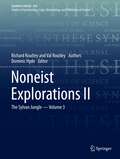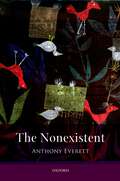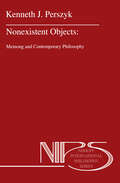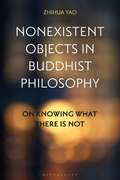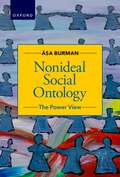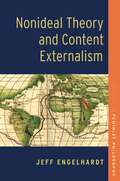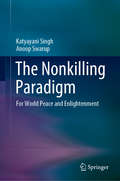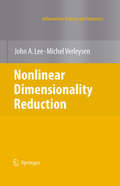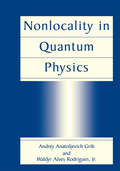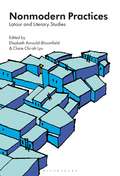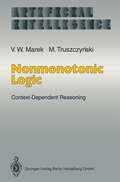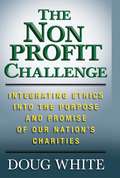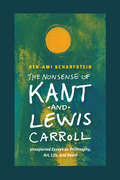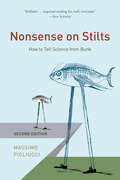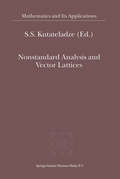- Table View
- List View
Noneist Explorations II: The Sylvan Jungle - Volume 3 (Synthese Library #432)
by Richard Routley Val RoutleyThis third volume continues Richard Routley's explorations of an improved Meinongian account of non-referring and intensional discourse (including joint work with Val Routley, later Val Plumwood). It focuses on the essays 8 to 12 of the original monograph, Exploring Meinong's Jungle and Beyond, following on from the material of the first two volumes and further explores aspects and implications of the Noneist position. It begins with a discussion of the value of nonexistent objects championed by noneism, especially as regards theories of perception, universals, value theory and a commonsense account of belief. It continues with: a detailed analysis of what it means to exist; the importance of nonexistent objects to adequate accounts of mathematics and the theoretical sciences; and an account of noneisms' distinctiveness from other accounts of nonexistent objects. These essays are supplemented with scholarly essays from Naoya Fujikawa, and Maureen Eckert and Charlie Donahue.
The Nonexistent
by Anthony EverettAnthony Everett defends the commonsense view that there are no such things as fictional people, places, and things. More precisely he develops and defends a pretense theoretic account on which there are no such things as fictional objects and our talk and thought that purports to be about them takes place within the scope of a pretense. Nevertheless we may mistakenly suppose there are fictional objects because we mistake the fact that certain utterances count as true within the pretense, and convey veridical information about the real world, for the genuine truth of those utterances. In the first half of The Nonexistent an account of this form is motivated, developed in detail, and defended from objections. The second half of the book then argues against fictional realism, the view that we should accept fictional objects into our ontology. First it is argued that the standard arguments offered for fictional realism all fail. Then a series of problems are raised for fictional realism. The upshot of these is that fictional realism provides an inadequate account of a significant range of talk and thought that purports to concern fictional objects. In contrast the pretense theoretic account developed earlier provides a very straightforward and attractive account of these cases and of fictional character discourse in general. Overall, Everett argues that we gain little but lose much by accepting fictional realism.
Nonexistent Objects: Meinong and Contemporary Philosophy (Nijhoff International Philosophy Series #49)
by K.J. PerszykIssues surrounding the status and nature of `nonexistent objects' constitute one of philosophy's oldest and densest thickets. In this book Perszyk takes his readers surefootedly through this thicket, informed both historically and at the level of contemporary discussion of relevant themes. His main aim is to develop a `bundle' or `set of properties' interpretation of Meinong's theory of nonexistent objects (as opposed to a set of properties neo-Meinongian metaphysics), and to defend this nonstandard interpretation against competing views in both the philosophical and scholarly literature on Meinong. The Meinong who emerges is neither the hero nor the villain his friends and foes have commonly led us to believe. This clearly written book is a valuable addition both to the literature on Meinong and to contemporary metaphysics of modality. It is written for students and professionals interested in these, and related, areas.
Nonexistent Objects in Buddhist Philosophy: On Knowing What There is Not
by Zhihua YaoCan we know what there is not? This book examines the historical development of the concept of the cognition of nonexistent objects in several major Buddhist philosophical schools. Beginning with a study of the historical development of the concept in Mahasamghika, Darstantika, Yogacara and Sautrantika, it evaluates how successfully they have argued against the extreme view of their main opponent the Sarvastivadins and established their view that one can know what there is not. It also includes thematic studies on the epistemological issues of nonexistence, discussing making sense of empty terms, controversies over negative judgments, and a proper classification of the conceptions of nothing or nonexistence. Taking a comparative approach to these topics, this book considers contemporary Western philosophers such as Husserl, Heidegger, Meinong and Russell alongside representative figures of the Buddhist Pramana School. Based on first-hand study of primary sources in Sanskrit, Chinese and Tibetan, Nonexistent Objects in Buddhist Philosophy makes available the rich discussions and debates on the epistemological issues of nonexistence in Buddhist philosophy to students and researchers in Asian and comparative philosophy.
Nonexistent Objects in Buddhist Philosophy: On Knowing What There is Not
by Zhihua YaoCan we know what there is not? This book examines the historical development of the concept of the cognition of nonexistent objects in several major Buddhist philosophical schools. Beginning with a study of the historical development of the concept in Mahasamghika, Darstantika, Yogacara and Sautrantika, it evaluates how successfully they have argued against the extreme view of their main opponent the Sarvastivadins and established their view that one can know what there is not. It also includes thematic studies on the epistemological issues of nonexistence, discussing making sense of empty terms, controversies over negative judgments, and a proper classification of the conceptions of nothing or nonexistence. Taking a comparative approach to these topics, this book considers contemporary Western philosophers such as Husserl, Heidegger, Meinong and Russell alongside representative figures of the Buddhist Pramana School. Based on first-hand study of primary sources in Sanskrit, Chinese and Tibetan, Nonexistent Objects in Buddhist Philosophy makes available the rich discussions and debates on the epistemological issues of nonexistence in Buddhist philosophy to students and researchers in Asian and comparative philosophy.
Nonideal Social Ontology: The Power View
by Åsa BurmanContemporary social ontology is a rapidly growing but divided area of study. In Nonideal Social Ontology, Åsa Burman provides a systematic overview and synthesis of core ideas in the field by showing that its key questions and central dividing lines can be fruitfully reconstructed as a clash between ideal and nonideal social ontology. Burman argues for the use of nonideal theory in social ontology, claiming that a paradigm shift from ideal to nonideal social ontology is underway, and that this shift should be fully followed through. Burman offers a new theory, called the Power View, of nonideal social ontology. It uses social power as the central building block, showing how this can partly bridge the divide between ideal and nonideal social ontology. The Power View replaces the flat and narrow conception of social power in ideal social ontology with a richer and more extensive conception. In addition, it rectifies a shortcoming in other theories of nonideal social ontology by attending to class, which has been notably overlooked in that literature.
Nonideal Social Ontology: The Power View
by Åsa BurmanContemporary social ontology is a rapidly growing but divided area of study. In Nonideal Social Ontology, Åsa Burman provides a systematic overview and synthesis of core ideas in the field by showing that its key questions and central dividing lines can be fruitfully reconstructed as a clash between ideal and nonideal social ontology. Burman argues for the use of nonideal theory in social ontology, claiming that a paradigm shift from ideal to nonideal social ontology is underway, and that this shift should be fully followed through. Burman offers a new theory, called the Power View, of nonideal social ontology. It uses social power as the central building block, showing how this can partly bridge the divide between ideal and nonideal social ontology. The Power View replaces the flat and narrow conception of social power in ideal social ontology with a richer and more extensive conception. In addition, it rectifies a shortcoming in other theories of nonideal social ontology by attending to class, which has been notably overlooked in that literature.
Nonideal Theory and Content Externalism (Studies in Feminist Philosophy)
by Jeff EngelhardtThis book charges that just about every philosophical theory of mind or language developed over the past 50 years in the West is systematically inaccurate. Systemic oppression has influenced the processes that theories of mind or language purport to identify; however, that same systemic oppression has also made it so that most middle-to-upper class White men (including most philosophers of mind or language) are ignorant of systemic oppression. Consequently, most theories of mind or language are systematically inaccurate because they fail to account for the influences of systemic oppression. Philosopher Jeff Engelhardt argues for the de-idealization of two influential theories in the philosophy of mind and language--social externalism and objective type externalism--and considers some consequences of the de-idealization project. Following the work of Charles Mills, Engelhardt argues that ideal theories adopt oppression-obscuring assumptions while nonideal theories avoid them (or at least try to). Ideal theories assume that language users are basically equal, and that social institutions and structures are basically just, but scholarship on Western social relations, institutions, and structures shows that in fact each of these is systematically influenced by oppression. Consequently, ideal theories tend to be systematically inaccurate. Moreover, since oppression systematically produces ignorance of systemic oppression, such systematically inaccurate theories are likely the norm rather than the exception. Engelhardt shows that once we've shown that oppression systematically influences the processes that determine linguistic meanings (according to content externalism), then we have reason to expand our notion of hermeneutical injustice, we have evidence that hermeneutical injustice occurs systematically, and we have grounds for expanding discussions of conceptual engineering to include questions about engineering the processes that determine concepts, not just concepts themselves.
Nonideal Theory and Content Externalism (Studies in Feminist Philosophy)
by Jeff EngelhardtThis book charges that just about every philosophical theory of mind or language developed over the past 50 years in the West is systematically inaccurate. Systemic oppression has influenced the processes that theories of mind or language purport to identify; however, that same systemic oppression has also made it so that most middle-to-upper class White men (including most philosophers of mind or language) are ignorant of systemic oppression. Consequently, most theories of mind or language are systematically inaccurate because they fail to account for the influences of systemic oppression. Philosopher Jeff Engelhardt argues for the de-idealization of two influential theories in the philosophy of mind and language--social externalism and objective type externalism--and considers some consequences of the de-idealization project. Following the work of Charles Mills, Engelhardt argues that ideal theories adopt oppression-obscuring assumptions while nonideal theories avoid them (or at least try to). Ideal theories assume that language users are basically equal, and that social institutions and structures are basically just, but scholarship on Western social relations, institutions, and structures shows that in fact each of these is systematically influenced by oppression. Consequently, ideal theories tend to be systematically inaccurate. Moreover, since oppression systematically produces ignorance of systemic oppression, such systematically inaccurate theories are likely the norm rather than the exception. Engelhardt shows that once we've shown that oppression systematically influences the processes that determine linguistic meanings (according to content externalism), then we have reason to expand our notion of hermeneutical injustice, we have evidence that hermeneutical injustice occurs systematically, and we have grounds for expanding discussions of conceptual engineering to include questions about engineering the processes that determine concepts, not just concepts themselves.
The Nonkilling Paradigm: For World Peace and Enlightenment
by Katyayani Singh Anoop SwarupThis book addresses the human civilizational ethos and explores the concept of the nonkilling paradigm concerning human dignity, human rights, affirmative nonkilling, positive peace and the advancement of human existence. It focuses on the complex question of how to mitigate the prevalent lethal actions and lay out a roadmap for a large-scale transformation of global society into a nonkilling one. It examines the lives of charismatic socio-political leaders who have played a vital role in achieving revolutions in their respective contexts and societies, and studies these revolutions from a nonkilling perspective, investigating the number of human lives lost, both during and after the revolution, due to deliberate actions on the part of leaders. In closing, it assesses the global status quo and current trends and presents a Global Nonkilling Index to record deliberate killings around the world. The book is a significant addition to the literature, specifically in the field of reinterpreting Gandhian concepts in the light of contemporary needs. Given its scope, the book is of immense value to researchers and practitioners in the areas of political science, philosophy, sociology & peace studies. Moreover, it is a must-read for everyone interested in promoting global nonviolence, nonkilling & peace.
Nonlinear Dimensionality Reduction (Information Science and Statistics)
by John A. Lee Michel VerleysenThis book describes established and advanced methods for reducing the dimensionality of numerical databases. Each description starts from intuitive ideas, develops the necessary mathematical details, and ends by outlining the algorithmic implementation. The text provides a lucid summary of facts and concepts relating to well-known methods as well as recent developments in nonlinear dimensionality reduction. Methods are all described from a unifying point of view, which helps to highlight their respective strengths and shortcomings. The presentation will appeal to statisticians, computer scientists and data analysts, and other practitioners having a basic background in statistics or computational learning.
Nonlocality in Quantum Physics
by Andrey Anatoljevich Grib Waldyr Alves Rodrigues Jr.The nonlocality phenomena exhibited by entangled quantum systems are certainly one of the most extraordinary aspects of quantum theory. This book discusses this phe nomenon according to several points of view, i.e., according to different interpretations of the mathematics of the quantum formalism. The several interpretations of the Copenhagen interpretation, the many worlds, the de Broglie-Bohm, quantum logics, the decohering by the environment approach and the histories approach interpretations are scrutinized and criticized in detail. Recent results on cryptography, quantum bit commitment, quantum erasers and teleportation are also presented and discussed. In preparing the book we benefited from discussions with many people, but we would like, in particular, to express our gratitude to Professor B. d'Espagnat for his useful comments and suggestions. We are grateful also to Ms. L. Gentry EI-Dash for the English revision, to Dr. 1. E. Maiorino for the production of the figures and a careful reading of the manuscript, and for the statI of Plenum for advice and for having produced a nice book. Finally, the authors thank FAPESP (contract no. I 99612657-0) for a grant making this book possible. A. A. ORIB AND W. A. RODRIGUES, JR.
Nonmodern Practices: Latour and Literary Studies
by Elisabeth Arnould-Bloomfield and Claire Chi-ah LyuThis collection of essays responds to the urgent call in the humanities to go beyond the act of negative critique which, so far, has been the dominant form of intellectual inquiry in academia. The contributors take their inspiration from Bruno Latour's pragmatic, relational approach and his philosophy of hybrid world where culture is immanent to nature and knowledge is tied to the things it co-creates. In such a world, nature, society, and discourse relate to, rather than negate, each other. The 11 essays, ranging from early modern humanism and modern theorization of literature to contemporary political ecology and animal studies, propose new productive ways of thinking, reading, and writing with, not against, the world. In carrying out concrete practices that are inclusive, rather than exclusive, contributors strive to exemplify a form of scholarship that might be better attuned to the concerns of our post-humanist era.
Nonmodern Practices: Latour and Literary Studies
This collection of essays responds to the urgent call in the humanities to go beyond the act of negative critique which, so far, has been the dominant form of intellectual inquiry in academia. The contributors take their inspiration from Bruno Latour's pragmatic, relational approach and his philosophy of hybrid world where culture is immanent to nature and knowledge is tied to the things it co-creates. In such a world, nature, society, and discourse relate to, rather than negate, each other. The 11 essays, ranging from early modern humanism and modern theorization of literature to contemporary political ecology and animal studies, propose new productive ways of thinking, reading, and writing with, not against, the world. In carrying out concrete practices that are inclusive, rather than exclusive, contributors strive to exemplify a form of scholarship that might be better attuned to the concerns of our post-humanist era.
Nonmonotonic Logic: Context-Dependent Reasoning (Artificial Intelligence)
by V. Wiktor Marek Miroslaw TruszczynskiWhen I first participated in exploring theories of nonmonotonic reasoning in the late 1970s, I had no idea of the wealth of conceptual and mathematical results that would emerge from those halting first steps. This book by Wiktor Marek and Miroslaw Truszczynski is an elegant treatment of a large body of these results. It provides the first comprehensive treatment of two influen tial nonmonotonic logics - autoepistemic and default logic - and describes a number of surprising and deep unifying relationships between them. It also relates them to various modal logics studied in the philosophical logic litera ture, and provides a thorough treatment of their applications as foundations for logic programming semantics and for truth maintenance systems. It is particularly appropriate that Marek and Truszczynski should have authored this book, since so much of the research that went into these results is due to them. Both authors were trained in the Polish school of logic and they bring to their research and writing the logical insights and sophisticated mathematics that one would expect from such a background. I believe that this book is a splendid example of the intellectual maturity of the field of artificial intelligence, and that it will provide a model of scholarship for us all for many years to come. Ray Reiter Department of Computer Science University of Toronto Toronto, Canada M5S 1A4 and The Canadian Institute for Advanced Research Table of Contents 1 1 Introduction .........
The Nonprofit Challenge: Integrating Ethics into the Purpose and Promise of Our Nation’s Charities
by D. WhiteThis book describes the challenges facing charities, explains how they must reassess their commitment, and pushes charities to be their best. It also examines how two sectors of society - business and government - would benefit from a similar corrective journey.
The Nonsense of Kant and Lewis Carroll: Unexpected Essays on Philosophy, Art, Life, and Death
by Ben-Ami ScharfsteinWhat if Immanuel Kant floated down from his transcendental heights, straight through Alice’s rabbit hole, and into the fabulous world of Lewis Carroll? For Ben-Ami Scharfstein this is a wonderfully instructive scenario and the perfect way to begin this wide-ranging collection of decades of startlingly synthesized thought. Combining a deep knowledge of psychology, cultural anthropology, art history, and the history of religions—not to mention philosophy—he demonstrates again and again the unpredictability of writing and thought and how they can teach us about our experiences. Scharfstein begins with essays on the nature of philosophy itself, moving from an autobiographical account of the trials of being a comparativist to philosophy’s function in the outside world to the fear of death in Kant and Hume. From there he explores an impressive array of art: from China and Japan to India and the West; from an essay on sadistic and masochistic body art to one on the epistemology of the deaf and the blind. He then returns to philosophy, writing on Machiavelli and political ruthlessness, then on the ineffable, and closes with a review of Walter Kaufmann’s multivolume look at the essence of humanity, Discovering the Mind. Altogether, these essays are a testament to adventurous thought, the kind that leaps to the furthest reaches of the possible.
The Nonsense of Kant and Lewis Carroll: Unexpected Essays on Philosophy, Art, Life, and Death
by Ben-Ami ScharfsteinWhat if Immanuel Kant floated down from his transcendental heights, straight through Alice’s rabbit hole, and into the fabulous world of Lewis Carroll? For Ben-Ami Scharfstein this is a wonderfully instructive scenario and the perfect way to begin this wide-ranging collection of decades of startlingly synthesized thought. Combining a deep knowledge of psychology, cultural anthropology, art history, and the history of religions—not to mention philosophy—he demonstrates again and again the unpredictability of writing and thought and how they can teach us about our experiences. Scharfstein begins with essays on the nature of philosophy itself, moving from an autobiographical account of the trials of being a comparativist to philosophy’s function in the outside world to the fear of death in Kant and Hume. From there he explores an impressive array of art: from China and Japan to India and the West; from an essay on sadistic and masochistic body art to one on the epistemology of the deaf and the blind. He then returns to philosophy, writing on Machiavelli and political ruthlessness, then on the ineffable, and closes with a review of Walter Kaufmann’s multivolume look at the essence of humanity, Discovering the Mind. Altogether, these essays are a testament to adventurous thought, the kind that leaps to the furthest reaches of the possible.
The Nonsense of Kant and Lewis Carroll: Unexpected Essays on Philosophy, Art, Life, and Death
by Ben-Ami ScharfsteinWhat if Immanuel Kant floated down from his transcendental heights, straight through Alice’s rabbit hole, and into the fabulous world of Lewis Carroll? For Ben-Ami Scharfstein this is a wonderfully instructive scenario and the perfect way to begin this wide-ranging collection of decades of startlingly synthesized thought. Combining a deep knowledge of psychology, cultural anthropology, art history, and the history of religions—not to mention philosophy—he demonstrates again and again the unpredictability of writing and thought and how they can teach us about our experiences. Scharfstein begins with essays on the nature of philosophy itself, moving from an autobiographical account of the trials of being a comparativist to philosophy’s function in the outside world to the fear of death in Kant and Hume. From there he explores an impressive array of art: from China and Japan to India and the West; from an essay on sadistic and masochistic body art to one on the epistemology of the deaf and the blind. He then returns to philosophy, writing on Machiavelli and political ruthlessness, then on the ineffable, and closes with a review of Walter Kaufmann’s multivolume look at the essence of humanity, Discovering the Mind. Altogether, these essays are a testament to adventurous thought, the kind that leaps to the furthest reaches of the possible.
The Nonsense of Kant and Lewis Carroll: Unexpected Essays on Philosophy, Art, Life, and Death
by Ben-Ami ScharfsteinWhat if Immanuel Kant floated down from his transcendental heights, straight through Alice’s rabbit hole, and into the fabulous world of Lewis Carroll? For Ben-Ami Scharfstein this is a wonderfully instructive scenario and the perfect way to begin this wide-ranging collection of decades of startlingly synthesized thought. Combining a deep knowledge of psychology, cultural anthropology, art history, and the history of religions—not to mention philosophy—he demonstrates again and again the unpredictability of writing and thought and how they can teach us about our experiences. Scharfstein begins with essays on the nature of philosophy itself, moving from an autobiographical account of the trials of being a comparativist to philosophy’s function in the outside world to the fear of death in Kant and Hume. From there he explores an impressive array of art: from China and Japan to India and the West; from an essay on sadistic and masochistic body art to one on the epistemology of the deaf and the blind. He then returns to philosophy, writing on Machiavelli and political ruthlessness, then on the ineffable, and closes with a review of Walter Kaufmann’s multivolume look at the essence of humanity, Discovering the Mind. Altogether, these essays are a testament to adventurous thought, the kind that leaps to the furthest reaches of the possible.
Nonsense on Stilts
by Massimo PigliucciRecent polls suggest that fewer than 40 percent of Americans believe in Darwin’s theory of evolution, despite it being one of science’s best-established findings. Parents still refuse to vaccinate their children for fear it causes autism, though this link has been consistently disproved. And about 40 percent of Americans believe that the threat of global warming is exaggerated, including many political leaders. In this era of fake news and alternative facts, there is more bunk than ever. But why do people believe in it? And what causes them to embrace such pseudoscientific beliefs and practices? In this fully revised second edition, noted skeptic Massimo Pigliucci sets out to separate the fact from the fantasy in an entertaining exploration of the nature of science, the borderlands of fringe science, and—borrowing a famous phrase from philosopher Jeremy Bentham—the nonsense on stilts. Presenting case studies on a number of controversial topics, Pigliucci cuts through the ambiguity surrounding science to look more closely at how science is conducted, how it is disseminated, how it is interpreted, and what it means to our society. The result is in many ways a “taxonomy of bunk” that explores the intersection of science and culture at large. No one—neither the public intellectuals in the culture wars between defenders and detractors of science nor the believers of pseudoscience themselves—is spared Pigliucci’s incisive analysis in this timely reminder of the need to maintain a line between expertise and assumption. Broad in scope and implication, Nonsense on Stilts is a captivating guide for the intelligent citizen who wishes to make up her own mind while navigating the perilous debates that will shape the future of our planet.
Nonsense on Stilts
by Massimo PigliucciRecent polls suggest that fewer than 40 percent of Americans believe in Darwin’s theory of evolution, despite it being one of science’s best-established findings. Parents still refuse to vaccinate their children for fear it causes autism, though this link has been consistently disproved. And about 40 percent of Americans believe that the threat of global warming is exaggerated, including many political leaders. In this era of fake news and alternative facts, there is more bunk than ever. But why do people believe in it? And what causes them to embrace such pseudoscientific beliefs and practices? In this fully revised second edition, noted skeptic Massimo Pigliucci sets out to separate the fact from the fantasy in an entertaining exploration of the nature of science, the borderlands of fringe science, and—borrowing a famous phrase from philosopher Jeremy Bentham—the nonsense on stilts. Presenting case studies on a number of controversial topics, Pigliucci cuts through the ambiguity surrounding science to look more closely at how science is conducted, how it is disseminated, how it is interpreted, and what it means to our society. The result is in many ways a “taxonomy of bunk” that explores the intersection of science and culture at large. No one—neither the public intellectuals in the culture wars between defenders and detractors of science nor the believers of pseudoscience themselves—is spared Pigliucci’s incisive analysis in this timely reminder of the need to maintain a line between expertise and assumption. Broad in scope and implication, Nonsense on Stilts is a captivating guide for the intelligent citizen who wishes to make up her own mind while navigating the perilous debates that will shape the future of our planet.
Nonsense on Stilts: How To Tell Science From Bunk
by Massimo PigliucciRecent polls suggest that fewer than 40 percent of Americans believe in Darwin’s theory of evolution, despite it being one of science’s best-established findings. Parents still refuse to vaccinate their children for fear it causes autism, though this link has been consistently disproved. And about 40 percent of Americans believe that the threat of global warming is exaggerated, including many political leaders. In this era of fake news and alternative facts, there is more bunk than ever. But why do people believe in it? And what causes them to embrace such pseudoscientific beliefs and practices? In this fully revised second edition, noted skeptic Massimo Pigliucci sets out to separate the fact from the fantasy in an entertaining exploration of the nature of science, the borderlands of fringe science, and—borrowing a famous phrase from philosopher Jeremy Bentham—the nonsense on stilts. Presenting case studies on a number of controversial topics, Pigliucci cuts through the ambiguity surrounding science to look more closely at how science is conducted, how it is disseminated, how it is interpreted, and what it means to our society. The result is in many ways a “taxonomy of bunk” that explores the intersection of science and culture at large. No one—neither the public intellectuals in the culture wars between defenders and detractors of science nor the believers of pseudoscience themselves—is spared Pigliucci’s incisive analysis in this timely reminder of the need to maintain a line between expertise and assumption. Broad in scope and implication, Nonsense on Stilts is a captivating guide for the intelligent citizen who wishes to make up her own mind while navigating the perilous debates that will shape the future of our planet.
Nonsense on Stilts: How To Tell Science From Bunk
by Massimo PigliucciRecent polls suggest that fewer than 40 percent of Americans believe in Darwin’s theory of evolution, despite it being one of science’s best-established findings. Parents still refuse to vaccinate their children for fear it causes autism, though this link has been consistently disproved. And about 40 percent of Americans believe that the threat of global warming is exaggerated, including many political leaders. In this era of fake news and alternative facts, there is more bunk than ever. But why do people believe in it? And what causes them to embrace such pseudoscientific beliefs and practices? In this fully revised second edition, noted skeptic Massimo Pigliucci sets out to separate the fact from the fantasy in an entertaining exploration of the nature of science, the borderlands of fringe science, and—borrowing a famous phrase from philosopher Jeremy Bentham—the nonsense on stilts. Presenting case studies on a number of controversial topics, Pigliucci cuts through the ambiguity surrounding science to look more closely at how science is conducted, how it is disseminated, how it is interpreted, and what it means to our society. The result is in many ways a “taxonomy of bunk” that explores the intersection of science and culture at large. No one—neither the public intellectuals in the culture wars between defenders and detractors of science nor the believers of pseudoscience themselves—is spared Pigliucci’s incisive analysis in this timely reminder of the need to maintain a line between expertise and assumption. Broad in scope and implication, Nonsense on Stilts is a captivating guide for the intelligent citizen who wishes to make up her own mind while navigating the perilous debates that will shape the future of our planet.
Nonstandard Analysis and Vector Lattices (Mathematics and Its Applications #525)
by Semën Samsonovich KutateladzeNonstandard methods of analysis consist generally in comparative study of two interpretations of a mathematical claim or construction given as a formal symbolic expression by means of two different set-theoretic models: one, a "standard" model and the other, a "nonstandard" model. The second half of the twentieth century is a period of significant progress in these methods and their rapid development in a few directions. The first of the latter appears often under the name coined by its inventor, A. Robinson. This memorable but slightly presumptuous and defiant term, non standard analysis, often swaps places with the term Robinsonian or classical non standard analysis. The characteristic feature of Robinsonian analysis is a frequent usage of many controversial concepts appealing to the actual infinitely small and infinitely large quantities that have resided happily in natural sciences from ancient times but were strictly forbidden in modern mathematics for many decades. The present-day achievements revive the forgotten term infinitesimal analysis which reminds us expressively of the heroic bygones of Calculus. Infinitesimal analysis expands rapidly, bringing about radical reconsideration of the general conceptual system of mathematics. The principal reasons for this progress are twofold. Firstly, infinitesimal analysis provides us with a novel under standing for the method of indivisibles rooted deeply in the mathematical classics.
